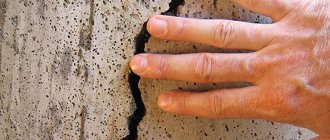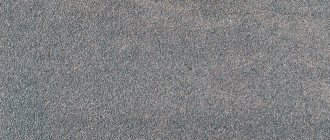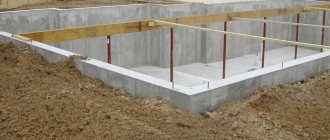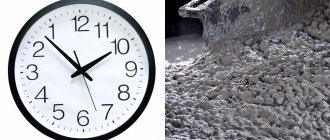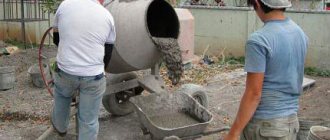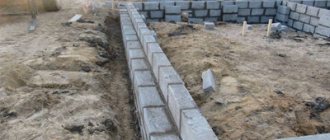Is it possible to pour the foundation in the fall? It is possible, but you need to take into account a number of factors, which you will read about in detail in this material. We will also look at when is the best time to pour a foundation and how to do it. The foundation must be strong and durable; autumn should not interfere with your construction. Autumn filling has its pros and cons. If you approach the work correctly, then at the end you can get a high-quality foundation that will not be inferior to the summer version. Gross mistakes can lead to the fact that instead of building load-bearing walls, you will have to remove defective concrete.
Construction of a private house in autumn
It's no secret that it is impossible to build a country house in just a few months. Unforeseen difficulties often arise that can stall the process for a long time. Even if construction of a cottage began in the spring, it is unlikely that everything will be completed in time for the winter cold. Well, if you are starting to build a house in the fall, then you definitely need to adhere to special rules for carrying out work in order to avoid many troubles in the future.
Preparation before pouring the foundation in the fall
To carry out foundation construction work in the fall, it is necessary to carefully plan the entire process in order to make the most of the advantages and avoid the disadvantages of the autumn period as much as possible.
The first step in planning will be choosing the area and marking it. These jobs can be done in the summer. Experts recommend digging a pit by the end of summer, beginning of autumn, so that the soil is not sufficiently wet or frozen. This choice is aimed at making digging easier. Also, before digging a pit, it is necessary to check for the presence of groundwater below the surface. When part of the pit has been dug, it is necessary to drill a small test shaft, as before digging wells, but to a much shallower depth. A few meters will be enough. If there is no water, you can safely continue work. If a source of water appears, it is necessary to choose another place to build a house, since the groundwater level rises significantly in winter and spring.
Experienced workers recommend pouring the foundation closer to mid-autumn, at the end of September and the first half of October.
A significant disadvantage of autumn is the unpredictability of the weather, as rain can appear at any moment. You should use the most accurate available weather forecasts to select a period with minimal precipitation and no frost. The presence of frost spoils the foundation that has not yet hardened; it tends to collapse from the inside during frost. Precipitation is not dangerous if it appears at least 2 days after pouring the foundation, by which time the concrete will have partially hardened.
It is necessary to take into account the characteristics of the soil in order to avoid subsidence of the foundation in winter due to water crystallization. The foundation hardens and stabilizes, depending on the area, for up to 6 months. In most cases, you can start laying walls already in winter. According to these recommendations and modern construction methods, it is definitely possible to build a foundation in the fall.
In addition, the price of building materials most often decreases in the fall, which allows you to save money. But if you carry out such work in winter, it will be difficult to make concrete yourself. There will be a need to order concrete from the plant, which will increase the cost of work.
Useful video about what to do at a construction site in late autumn:
What to look for when concreting a foundation
In order to competently carry out construction work and reduce further costs of repair and operation of the foundation to a minimum, you must adhere to a few simple rules:
- The foundation design should not allow cracks to form under any load.
- The entire volume of concrete must be poured without technological and “cold” joints, that is, in one technological cycle.
- If the work involves the formation of technological seams, they must be sealed using swelling cords, sealants or waterstops.
- Working reinforcement must be installed in strict accordance with the design; the thickness of the protective layer of concrete must be at least 15 mm.
- It is necessary to compact the laid concrete with vibrators or use self-compacting concrete.
- Newly laid concrete needs to be maintained.
The right time of year
It is necessary to think through construction in order to take advantage of the benefits of the autumn period. If you ask a professional builder what time of year is best to pour the foundation, he will answer you - in early autumn or spring. Two conditions must be met - warm weather and high humidity. Concrete takes about 25-30 days to gain the required strength.
In the first months of autumn, frosts occur, but quite rarely. If necessary, the structure can always be protected from low temperatures. As for groundwater and precipitation, they are not so dangerous for the foundation, since excess liquid can cause serious damage to the foundation only in the first days after pouring. The mixture sets in 24-40 hours, after which the concrete gains strength.
Can pregnant women be vaccinated against coronavirus? Who can get vaccinated?
An adult citizen of the Russian Federation or another state can become a participant in the study, provided he knows the Russian language (can fill out documents and communicate with research doctors), who has not had ARVI two weeks before the study and is not ill at the time of vaccination, has not had COVID-19 and had contact with coronavirus patients at least two weeks before the study.
Do those who have already had coronavirus need a vaccine?
First you need to get tested for antibodies. If the IgG level is above 10, then immunity has already formed and vaccination is not necessary.
Can the vaccine be used to treat people who are already sick?
The vaccine is intended to prevent the disease. If you have symptoms of COVID-19, you should not get vaccinated.
Can anyone who has had a flu shot get vaccinated? Does the coronavirus vaccine also protect against the flu?
Vaccination against coronavirus is allowed 30 days after any other vaccinations. However, it does not protect against the flu, so it is recommended to get both vaccinations.
Can pregnant women be vaccinated? Do maternity hospitals accept people without vaccination against coronavirus?
At the stage of post-registration clinical trials, vaccination of pregnant women is not carried out. Therefore, a coronavirus vaccination is not required for admission to the maternity hospital. Medical institutions take the necessary measures for the safety of mother and child. All patients are tested for COVID-19 upon admission. If the diagnosis is confirmed, the women are placed in separate rooms.
Can a child be vaccinated?
As part of post-registration clinical trials, only people over 18 years of age can be vaccinated against coronavirus.
Is it possible to vaccinate animals?
No, as part of post-registration clinical trials, only people over 18 years of age are vaccinated.
Who should not be vaccinated against coronavirus? Are there any contraindications?
Vaccination should not be given to those who have suffered acute coronary syndrome or stroke in the last year. Contraindications also include chronic systemic infections, tuberculosis, neoplasms, hepatitis B and C, syphilis, and HIV.
In addition, both women and men should not take part in the study if they plan to conceive a child in the next three months.
Is Moscow registration required?
No, any adult Russian citizen or foreign citizen living or working in Moscow can become a participant in the study.
Is it possible to participate in studies with a non-Moscow compulsory medical insurance policy?
Yes, any adult Russian citizen or foreign citizen living or working in Moscow can become a participant in the study.
Properties of concrete that benefit builders
When the mixture hardens, a chemical reaction occurs that causes heat. Thanks to this, the concrete dries better, but due to the fact that the ambient temperature is low, no voids are formed in it and it does not dry out. Therefore, the answer to the question whether it is possible to pour the foundation in the fall is unequivocal: yes. The most important thing in this matter is to carefully calculate everything. In addition, pouring concrete must be included in the construction plan; this will allow all the necessary materials, equipment and fixtures to be prepared in advance.
In cold weather it is better not to flood the pillars unless they are sufficiently insulated. Indeed, in such conditions, internal heat will be enough for a very short period of time, during which it will not have time to completely harden. It is better to limit yourself to only a low foundation, in which case the chemical reaction can continue and dry the solution much longer.
The period lasts several hours after preparing the solution. At this stage, you need to have time to complete the following processes:
- Transportation of the solution to the work site. This is especially true when ordering pre-fabricated concrete, since the production site may be located at a sufficient distance from the area where the foundation needs to be poured. The issue is solved by using special equipment - concrete mixers. Constant stirring increases the life of the solution.
- Laying the concrete mixture into the mold.
- Compaction (vibrating or pinning) and leveling.
The setting time depends on the ambient temperature, which is why it is so important to decide when it is best to pour the foundation for a house. To select the appropriate time, it is recommended that you familiarize yourself with the following table.
| Ambient air temperature (average daily value indicated), ᵒС | The period during which setting occurs (on average), the beginning and end of the process are indicated in hours |
| 30 | 1-2 |
| 20 | 2-3 |
| 6-20 |
How does frost affect the hardening of concrete?
Weather certainly affects the process of concrete gaining strength. But with the right approach to work, the foundation of the building will be even stronger than at any other time of the year. Otherwise, in the spring, instead of continuing construction, you will have to dispose of the damaged foundation. Features of the underground structure of a building in the fall are determined by the following factors:
- The optimal temperature is 15-25 degrees. In the absence of severe frosts, concrete hardening in autumn occurs slowly, but better than in summer or winter;
- humidity level, which is positively influenced by damp air and soil. At optimal humidity, concrete does not dry out;
- rains, which can reduce the content of cement laitance in the solution;
- an increase in the groundwater level due to precipitation, which threatens the flooding of trenches and pits and, consequently, the cessation of work.
The optimal time to pour the foundation is the beginning of autumn, when the heat has subsided, but frosts or heavy rains have not yet begun. It is required that such weather last for 28 days, because this is the period necessary for the concrete to gain its design strength. Rain and groundwater can affect the underground structure of structures only in the first two days, since then the solution sets and precipitation has little effect on it. In addition, moisture begins to have a positive effect, preventing the cement mortar from drying out.
To protect the underground part of the building from frost, you need to comply with more difficult conditions and be prepared to increase the necessary costs. After all, if the concrete freezes, the strength of the foundation of the building will decrease to such an extent that it can completely collapse. Another disadvantage is the increase in the cost of the zero cycle of work, that is, digging trenches and pits. Frozen ground is difficult to handle with a shovel, and therefore special equipment is required.
To save money and time, you can fill the foundation before frost begins. The most suitable month is September, when you can get by with the usual procedures. But if the work is still delayed, you will have to use various technologies used for pouring concrete mixture at subzero temperatures.
- We cover the foundation. The most economical and at the same time unreliable method. To protect the underground structure of a building, you simply need to cover it with insulating material, which will retain the heat generated by the soil and cement during the hardening process. You can use sawdust, mineral wool as insulation, or rent a shelter if you have the means. The method of completely covering the base of a building under construction is only suitable for a slight decrease in temperature, but it can still be used to gain several weeks.
- Special additives. For the normal process of gaining strength, special components are added to concrete. They are called plasticizers and allow you to pour the concrete mixture at -10 degrees. But there are also those that reduce the temperature to -20 degrees. It is not difficult to guess that their cost will, of course, be higher. The disadvantage of the method is that it can only be used in conjunction with other technologies.
- We heat the concrete mixture. Quite a costly and troublesome method. When heating a structure, it is necessary to calculate the power of the cables laid on the foundation and the optimal temperature regime, since the solution should not overheat. Experts advise not to carry out this procedure yourself, because there is a very high probability of ruining everything.
- We are constructing thermal formwork. Just like the previous one, this method is difficult to perform independently. As a rule, such formwork is used only by construction companies in harsh working conditions or the impossibility of deferring them until the onset of spring.
- Dry the concrete. To pour concrete in the fall, you must also avoid dampness. The problem of excess moisture is solved by placing a heat gun under the awning. It evaporates moisture by filling the space under the awning with warm air. You can dry the underground structure of the structure in any frost.
Protection of setting and hardening concrete from frost
Partial or complete freezing of concrete until the strength reaches 75-80% is a guaranteed partial or complete destruction of the structure after thawing. As you know, Russian autumn is unpredictable.
Frosts can occur as early as late September or early October. Therefore, you need to be prepared to protect a freshly poured concrete structure in one or more ways:
- Carefully covering the surface with available heat-insulating materials. The method is only suitable for protecting foundations and other structures located no higher than the zero level. If the air temperature suddenly drops to minus 5-10 degrees Celsius, the surface is covered with sawdust and covered with mineral wool or other heat-insulating material. You can also rent or build a temporary tent over the structure. The soil cools down over several weeks, and heat is generated as the concrete hardens. In this regard, with high-quality implementation of this activity, you can win back 1-2 weeks from nature, however, in severe frosts this method is ineffective;
- Use of antifreeze additives. Depending on the type, antifreeze additives allow concrete to “calmly” gain grade strength when the temperature drops to minus 10 and even minus 25 degrees Celsius. Among the most popular antifreeze additives are: calcium nitrate (“works” down to minus 25 degrees Celsius), M15plus and M25plus (“works” up to minus 15 and minus 25 degrees Celsius, respectively), MorozStop (“works” up to minus 15 degrees Celsius), Potash (“works” down to minus 25 degrees Celsius), calcium formate – lowers the freezing point to minus 20-25 degrees Celsius, depending on the concentration;
- Active heating in one or more ways: a heating cable located on the surface of the concrete, covered with thermal insulation, a heating cable located in the thickness of the structure (remains there forever), a tent and heat guns (electric guns, infrared lamps, etc.) or thermal formwork. In this case, it is very important not only to warm up, but also not to overheat the concrete. Therefore, active heating of concrete should be trusted to specialists.
Quality concrete all year round
Modern construction chemicals and technologies for caring for hardening concrete make it possible to pour the foundation in winter. At the same time, winter concreting of the foundation is more labor-intensive and expensive than summer concreting. This work requires strict adherence to the temperature regime of the concrete mixture, so any mistake can lead to a significant loss of foundation strength.
The answer to the question at what temperature the foundation can be poured will be: it is cheaper and easier to do this work during a period of stable heat. For clarity, let’s compare the costs of concrete. If in summer, spring and autumn it can be prepared directly at the construction site, then in December and other winter months you will have to order concrete mixture from the factory and pay extra for anti-frost additives.
In addition, you will have to use electrical heating of the concrete, which will also require money and time. As a result, winter concrete will cost 30-40% more than summer concrete.
If the circumstances are such that the foundation will have to be poured in winter, you need to prepare the necessary equipment for electrical heating in advance, find a competent specialist, or independently master the basics of this technology. It also doesn’t hurt to stock up in advance on a sufficient amount of insulating materials - sawdust, shavings or foam.
Those who want to pour a foundation in the fall or spring should remember that these periods of the year are very dangerous for concrete. Autumn and spring frosts, when the temperature constantly crosses zero, cause irreparable damage to concrete. Therefore, you need to insure yourself by adding anti-freeze compounds or plan work for a period when weather forecasters promise stable above-zero temperatures.
When deciding when is the best time to pour a foundation , be sure to take further construction work into account. It’s one thing when you pour the foundation in the fall and take a break until spring. If, after autumn concreting, you plan to start laying walls, then work with concrete should begin as early as possible.
The fact is that concrete, even at an air temperature of +23C, will require at least 3 weeks to gain standard strength. At lower temperatures this period increases noticeably. Therefore, pour the foundation (without chemical additives in concrete) no later than August. In this case, by the beginning of the autumn cooling it will be possible to begin laying walls and installing floors.
What happens if the temperature regime is not maintained?
If you are in doubt at what temperature is best to pour the concrete mixture, consult with experienced builders. If existing requirements for concreting at certain times of the year are not met, negative changes may occur to the concrete base of the building:
- cracks will appear. As a rule, they are formed at temperatures exceeding twenty degrees Celsius, unless the uniformity of moisture drying and the process of hardening are controlled. As a rule, the poured base is covered with a film and periodically moistened;
- Microcracks form inside the foundation. At what temperature in spring and at what autumn does this happen? If the air does not warm up above three degrees Celsius, the water begins to transform into ice, increasing its volume. Then it dries, leaving behind microscopic cracks that contribute to the destruction of the concrete base;
- displacements are observed. When frozen sand or gravel is used to mix a concrete mass, pieces of ice get into the mass, forming void areas. Under the influence of the maximum load, the foundation base shifts;
- tension increases. The reinforcement frame of the future foundation, welded at a negative temperature, will expand in volume in warm weather and create increased stress on the structure, leading to emergency situations.
Pouring concrete in the fall: where to start?
When planning the construction of a concrete structure in the autumn, you should know what weather factors affect the quality of the final product or structure. There are several objective factors, and they are well known to construction specialists:
- Ambient temperature. The optimal temperature regime for setting and strengthening of concrete is a temperature “differential” from 16 to 25 degrees Celsius. As the temperature decreases, cement hydration slows down, which has a positive effect on strength gain. It is very important that the concrete does not freeze. If this happens, the frozen water will literally “tear” the flooded structure from the inside. This is the main danger that comes with pouring concrete in the fall;
- Increased environmental humidity. This is a positive factor that allows us to exclude constant wetting of the concrete surface from the technology;
- Rain and downpours erode concrete, wash cement out of the surface and reduce its strength. This is a negative factor;
- Groundwater. A negative factor that requires either carrying out measures to dry the site, or using special construction technology, or postponing construction to the summer.
At the same time, if you think through and prepare everything before carrying out work, you can avoid the influence of negative factors and take full advantage of the positive aspects of autumn - the absence of summer heat and high environmental humidity.
As already mentioned, the main danger for hardening concrete is a drop in temperature below 0 degrees Celsius. Moreover, given that concrete gains strength within 28 days, low temperatures will pose a danger within one month after pouring.
Precipitation and groundwater can only cause harm in the first 48 hours after pouring, and their harmful effects can be easily dealt with. Therefore, when pouring concrete in the fall, the structure should be protected from frost and the construction rules stipulated in the current SNiP 3.03.01-87 “Load-bearing and enclosing structures” should be strictly observed.
Filling at minimum temperature
In order to properly maintain concrete mortar to critical strength levels, you should know the features of existing methods for this, their advantages and disadvantages.
Note that certain methods are used in combination with some analogues, in most cases with preheating of the concrete solution.
Conditions conducive to proper curing must be created outside the building. They consist in maintaining a certain temperature around the concrete.
And yet, is it possible to pour a foundation at sub-zero temperatures? The problem is that in such work at subzero temperatures, the main problem is associated with the slow hardening of the concrete solution.
If pouring is carried out at zero temperature, the processes occurring in the solution during its hardening simply stop. The moisture remaining inside the foundation significantly increases its volume, tearing the surface.
To avoid such negative manifestations, builders use certain technological techniques:
- certain components of the mortar mixture and the formwork structure are heated;
- a special wire is laid inside the structure to provide heating;
- heating devices are installed around the foundation;
- Special antifreeze additives are introduced into the concrete solution, accelerating hardening or lowering the temperature at which water begins to freeze.
If you have to pour concrete under the foundation in winter, it is recommended to reduce the amount of water used for mixing the solution.
You must be prepared for the fact that the listed methods will significantly affect the construction budget in the direction of its increase. Such methods, as follows from the reviews, are rarely used by novice developers.
Particularly popular is the winter concreting method, which involves reducing the amount of water and cement material in the mixture. But in this case, the components must be mixed in strict proportions.
In such situations, a quick-hardening cement composition is used, preparing the solution in a certain way:
- two parts of water are heated to seventy degrees;
- mixing with sand or crushed stone is carried out;
- Cement is fed into the concrete mixer and the remaining amount of water is poured.
Before pouring concrete, ice is removed from the formwork and the underlying cushion is heated. The structure of a strip or other foundation is covered with polyethylene so that the heat near the foundation is retained for as long as possible.
Knowing to what temperatures the foundation can be poured, it is still necessary to clarify the weather forecast. It is quite possible that you will have to think through the heating system. In addition, even at subzero air temperatures, it will be necessary to install waterproofing.
There are many reasons why concrete is poured onto the foundation during the cold season. But there are some advantages to such work that are recommended to be taken into account:
- Without preheating the solution, you can concrete the foundation in the part of the object located below the surface of the earth. In warm weather, loose soil crumbles, but in frosty weather, concrete can be poured calmly, because the soil will hold its shape;
- Having figured out what temperature is best for pouring the foundation in the winter season, you will save a lot on the cost of materials, for which prices do not increase at this time of year.
For those who are interested in how to fill a foundation in winter at sub-zero temperatures, we note that there are certain disadvantages. First of all, you will face a labor-intensive process of constructing a pit, because the soil will freeze and will be difficult to excavate. In addition, the work will be carried out at a slow pace, and you will expect additional heating costs.
Taking into account all the features, each developer will have to decide for himself at what temperature the foundation should not be poured.
Will supplements help?
Experts say that you should not fill the foundation in winter without using special additives in the solution. It is believed that such additives solve all problems, since this method is the easiest for concreting at sub-zero temperatures, especially at night.
As developers assure, using additives, it is possible to pour a foundation at sub-zero temperatures without organizing heating. But if you work comprehensively, then by heating you will reduce cash costs.
If the minimum temperature for pouring the foundation causes you doubts, use one of the types of additives:
- substances and compounds that reduce the freezing point of water. With their help, normal hardening is achieved at negative temperatures. This group includes potash, calcium and sodium chlorides, sodium nitrite, combinations of such components and similar substances. The type of additive is determined taking into account the sub-zero temperature to which concreting is allowed;
- components and compounds that accelerate hardening. Among them are molasses, modifiers based on calcium chloride and urea, etc.
Additives are introduced in an amount of two to ten percent by weight of the cement material. Their volume is selected based on the temperature regime required for hardening of the artificial stone.
At what temperature in winter should additives be added? Builders use them at sub-zero temperatures of up to 25 degrees. But private developers should not resort to such experiments, since in reality such additives are used only at the first night frosts or with the onset of spring, when a foundation is needed for a specific period, and there are no other options for its construction.




